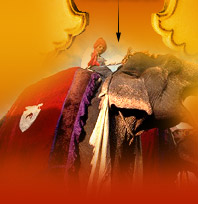 |
Shekhawati Travel Tours Guide Offers : - Online tourism tourist information about cultural heritage Shekhawati region of Rajasthan, havelis in Shekhawati, wildlife in Shekhawati, tourist place to visit in Shekhawati, living life in Shekhawati and also offers online customized package tours cultural, heritage sightseeing hub of rajasthan Shekhawati. |
 |
 |
|
 |
|
 |
Shekhawati
gets its name from the Rajput Kachhwaha chieftain Rao Shekha Ji. The descendants of Rao Shekha Ji are called Shekhawat. The story of Shekha’s birth is rather interesting to understand the origin of Shekhawati. Mokal JI and his Wife were much troubled as they had no son for several
years.  They heard about the miraculous powers of the Sheikh Burhan, a Muslim Saint. They decided to pay the man a visit. After they received the blessings of the Sheikh, a son was born to the couple. In honour of the mendicant, the couple named his son Shekha. The semidesert region of Shekhawati is a colorful fantasy having a fascination uniquely of its own. 'The open-air art gallery', as it is popularly called, is famous for its plethora of painted havelis, all commendable pieces of the rich artistic tradition of this region. The heritage experience that is distinctive to the Shekhawati region begins in Mandawa, a fine little market town that was once the stronghold of merchants. You can catch a glimpse of Rajasthani life in the havelis in this town. Brightly painted and ornate, these havelis add color to the somewhat-sleepy town. The haveli experience continues in Ramgarh, the bastion of the Poddar merchant family. This was once one of the richest town in the region. Some of the havelis dating back to the heydays of the Poddar clan still exist, and are worth looking at on your India Travel. The natural climatic conditions in the region are very harsh and extreme. The temperature ranges from sub-zero Celsius in winters to more than 50 °C in summers. The summers bring hot waves of air called loo. Annual rainfall is very low, of the scale of 450 to 600 mm. The ground water is as deep as 200 feet (60 m), and at places water is hard and salty. The people in the region depend on rainwater harvesting. The July and August rainwater is stored in pucca tanks and used throughout the year for drinking purposes.[4] Bawdis and johads are traditionally constructed for storing water received from rainfall in this arid region of Rajasthan. The bawdi is constructed in such a design that it gets narrower as we go down. The water stored in it is very cool and used for drinking purposes. On an average the region faces every third year as a dry year and every eighth year as a famine year. The famine of 1899 is considered to be the most severe. During famine years it becomes very difficult for animals to survive and the cattle population goes down drastically. Shekhawati Attractions
|
|||
|
Copyright © Golden Triangle Tours India. All Rights Reserved. Site Designed & Maintained by Sai Info Soft |